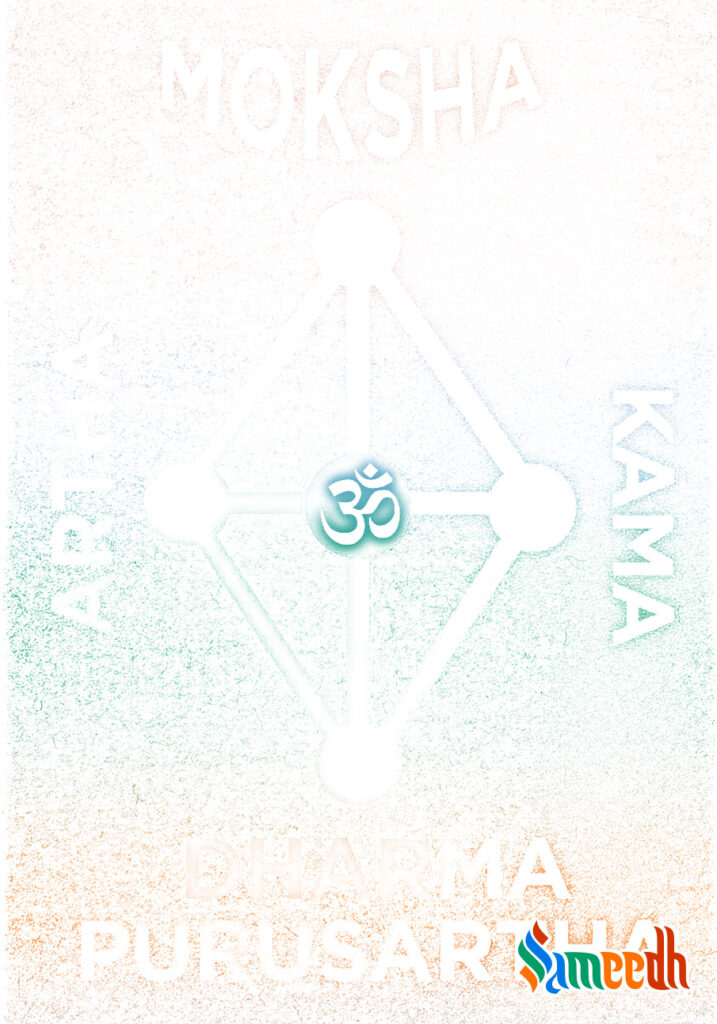The four major pursuits of life according to Hinduism, leading towards a peaceful and spiritually content life.

According to Hinduism, there are four life goals or Purushartha; Dharma, Arth, Kama, Moksha, which means the object of human pursuit or purpose of self. Throughout their existence, human beings strive to obtain and accomplish certain aims at mental, physical and spiritual levels. Ideally, a balance of all these goals should be struck as they go hand-in-hand. But if the focus remains on just one or two like Arth and Kama, then it can invite troubles in life. All these targets are beneficial for a spiritually fulfilled living.
Dharma
Dharma is often associated with religion but not always in a spiritual capacity. It extends to the code of conduct of justice, the ability to tell right from wrong, the privileges and duties alike. Dharma, the consciousness is what separates humans from other living creatures. It is the order of society that maintains a peaceful life amongst living beings, the balance between good and evil. Across Hindu epics such as Ramayan, Mahabharat and ancient scriptures like Vedas, the mention and preservation of Dharma have been discussed elaborately. Yudhisthir, Ram, Krishna and many other prominent incarnations of deities and brave personalities were born to restore Dharma and reestablish the laws of mankind.
The integral characteristics of Dharma involve patience, forgiveness, compassion, cleanliness, self-control, knowledge, wisdom, truth, benevolence, intellect, kindness, calm temperament and similar values. Dharma opposes not just causing harm to others through violence, cunning or power but also the very ill intentions of manifesting destruction, pain, or suffering.
The ultimate goal through Dharma is letting the nature of beings exist as is, harmony for all and periodic eradication of evil entities.
Arth
Arth is the materialistic tangible world around us, the financial resources, physical possessions. It also refers to the means through which one leads life, the way of sustaining with regards to social class or definition. It is the need to acquire wealth, have a respectable job, and a successful life overall. Arth is deemed to be an extremely crucial part of life by many, to take care of family, and children and live a comfortable life, capital is required. But the power lies in not placing Arth above Dharma. Acquisition or money or elevation in economic standards should be earned with hard work, knowledge and determination and not through mal practises. Arth in accordance with Dharma can guide one through both a happy and prosperous life. When one tries to gain riches through wrongdoings, without following Dharma or the laws of nature, it would end poorly.
Kama
Kama is the pleasure and enjoyment of life. Kama is the name of the Hindu god of love and lust. Along with wealth and materialistic comforts, healthy doses of pleasurable indulgences are essential to keep the human mind happy. Kama is not limited to the pleasure of senses, it extends to love for music, arts, passion or drives in life as well. Receiving and showering affection and care towards others, emotional experiences too are a part of Kama. It is about finding joy and excitement in what you do. An increased quest for Kama over Dharma can make individuals an addict, jealous, greedy, depressed, anxious and eventually suffer. For a proportionate balance of Kama in life, one can ensure that Kama aligns with their moral responsibilities and does not force them to overstep the boundaries of Dharma.
Moksha
Moksha is seen as the most significant goal according to Hinduism. It is the prime liberation from the cycle of birth, death and rebirth. Moksha leads one to self-actualization and realisation. To attain this state, one has to immerse themselves in meditative practices through a disciplined and knowledgeable approach. This life purpose provides the maximum level of mental peace where there are no titles or goals to be chased, the present itself is a phase of true contentment. It is also a state of detachment from desires and gains, where focus lies on accepting life as is, having no expectations or hope of imaginary scenarios or maya. It is considered difficult to achieve this Purushartha, but with sheer dedication, this too can be reached.